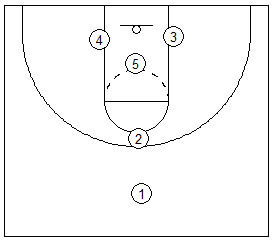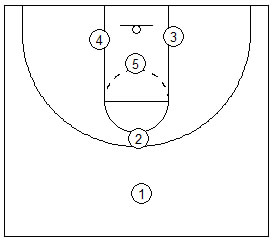
I believe that in coaching basketball, the defensive and offensive systems and styles that a basketball team employs must be complimentary.
In this post, I am going to concentrate on what I call the 6 phases of a defensive possession. I do have the 6 offensive phases posted as well. Here is a link to the 6 phases of offense.
The following is the system that I use to organize, teach, and evaluate each possession as it cycles from offense to defense.
My hope is that you can get a couple of ideas to apply to your team defense.
Basketball Defensive Phases
Phase #1 Defensive Conversion (Goal: no conversion points and force the ofther team to play against our halfcourt defense.)
When we shoot the ball, we go to the spots diagrammed at the left to give us offensive rebound coverage and to prepare to convert to defense.
So if #1 or #2 Shoot the ball, they do not follow their shot in our system. #2 (We call him our halfback) slows the ball as it is beirng advanced on the dribble. #1 (we call him our fullback) retreats to cover the basket.

The numbers are for explanation only, #1 is not necessarily the point guard. #3, #4, and #5 are our best three offensive rebounders, but 5 does not always go to the front of the rim. Our objective is to cover the block, block, and front of the rim for offensive rebounding. The players go to the first available.
Players 3, 4, and 5 inside fight for offensive rebound position. If the other team retrieves the rebound, those players SPRINT inside our defensive three point arc and match up. Our rule is that if you pick up the ball (#2s responsibility) you keep it, even if that is not who you are assigned to guard, until you are called off by the player who is guarding him.
Defensive Phase #2 Establish and maintain defensive spacing to be ready to help. This includes guarding the post. Our defense is a pack style man to man, so our players play more in gaps and help postion, but the same can be applied to a pressuring man to man or to a zone. The idea is to have all 5 players working and never relaxing.
The “establish'” part is our effort to get into initial help and post defense positions.
The “maintain” is the adjusting part as we defend the player movement and ball movement of the offense. We drill that by using the shell drill with various types of player movement in addition to the traditional stationary offense and position check shell drill.
When the ball is passed, we run on the air time of the pass to our new spots. Our expectation is that the player picking up the ball arrive Recovering applies to all 5 players, not just the player recovering to the ball. The other four are recovering to their post defense and gap positions.
Defensive Phase #3 Pressure the ball without giving up penetration and without fouling. We pressure the ball on the dribble one step off the arc and the passer when the ball is picked up. We chart deflections as a measure of how we are doing, but do not reach in for the ball. Our rule on taking the ball is to take it with two hands only and never reach with one.
Our defense is a helping defense, but we do not want to rely on help and continually get beat on the dribble. We work to keep the dribbler in front of us. “Guard your yard”–you need to guard the ball 3 feet in either direction without relying on help.
An important part of our pressure is great technique and intensity on our closeouts.
Defensive Phase #4 Keep the ball out of the lane It takes 5 players pressuring and contianing the basketball, defending post passes, and getting in their gaps to discourage penetrating dribbles. We start of in help position to keep the ball out of the paint, rather than deny, help, and recover. We do not deny non penetrating passes.
If the ball goes in the lane, trap it and force it to be thrown to the perimeter, then sprint to new defensive spacing spots, closeout on the ball and contain penetration. Keeping the ball out of the lane keeps us out of foul trouble and keeps the opponent from being able to take inside out shots.
It takes a continual effort to keep the bal out of the lane and I often paraphrase Dick Bennett when he said to one of his Wisconsin teams,: “We Must OUTLAST the offense on every possession! Great defense takes consistent effort and commitment to excellence, every second of every practice and every game. It is not good enough to just go through the motions, to give the impression that you are trying, that you care. You must take PRIDE in your defense, in your effort, and be committed to OUTLASTING your opponent. You have to believe that! Anything less gives our opponents the edge. Gentlemen, we must OUTLAST the offense on every possession. That must be our foundation.”
Defensive Phase #5 Contest every shot with mirror hand. That is, if it is a right handed shooter, we contest with our left hand, if it is a left handed shooter we contest with our right hand. The objective of our defense is to force contestd jump shots and then complet the possession with a rebound.
Cardinal rule do not foul a jump shooter. To emphasize contesting shots In practice, if a starter does not contest a shot, it is 2 points (or 3 if it is behind the arc) for the second team if the shot misses. If the shot goes in, we count it and add the extra 2 points or 3 points as well.
In a game, we chart contested shots. On a players second shot he doesn’t contest, he comes out of the game temporarily. Not for the rest of the game, but long enough to send a message.
Defensive Phase #6 Block out, pursue the ball, chin the rebound or dive on or chin all loose balls.
Finishing the possession is key. We don’t consider rebounding as a separate phase, we consider it as a part of the offensive or defensive possession. It is the part that concludes all of the hard work.
We don’t want to work relentlessly in the first five phases and then waste all of that work by not blocking out then going after the ball tenaciously.
We chart block out percentage from our game videos. We reward those with 90% for a game with a sticker on their locker.
We also give a sticker for collecting 8 or more rebounds. We take playing time away from players with consistently low percentages.
I also believe it is key to teach players to grab a loose ball with two hands and chin it rather than trying to dribble it. Chart and reward who gets the 50/50 balls and who is on the floor after them. There aren’t as many loose balls as rebounds per game, but each one is as important as a rebound because it can finish the possession on defense or continue the possession on offense.
Offensive Phases
I will be adding more description to these tomorrow
Offensive Phase #1 Presss Offense, Halfcourt Trap Offense, Transition. Never be surprised by a trap or full court press–always be prepared for them.
Offensive Phase #2 Spacing. Fill our spacing spots.
Offensive Phase #3 Sureness—catch triple threat, use bounce passes. Passing-push with outside hand to outside hand of receiver. Contact is never an excuse to loose the ball Fake a pass to make a pass.
Offensive Phase #4 Put the ball in the lane to score, to collapse the defense, and to get to the free throw line.
Offensive Phase #5 Shot selection—Who, what, when, where.
Offensive Phase #6 Fill rebound spots when the ball is shot (and the cycle starts over)
Here is a link to a more in depth discussion of the 6 phases of offense.







[…] link is to a post where I have shared some ideas on defensive conversion: 12 phases of a possession The video is a You Tube video, so please make sure that you are on a server that allows you to view […]